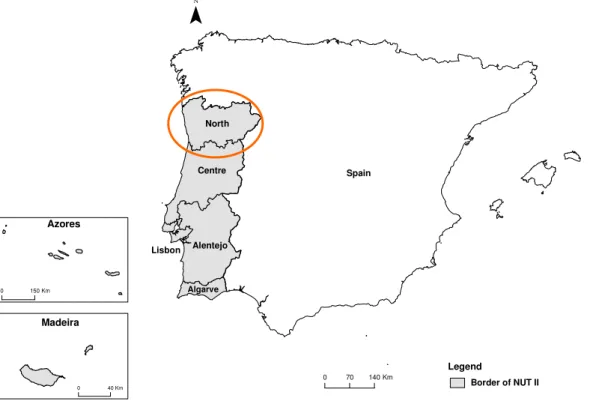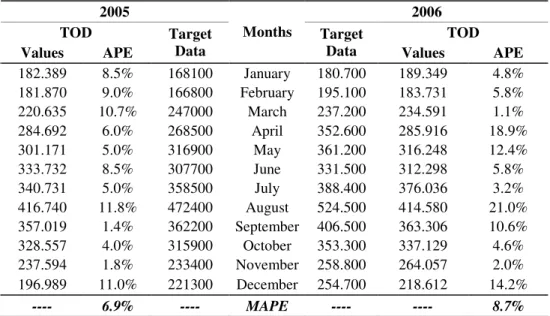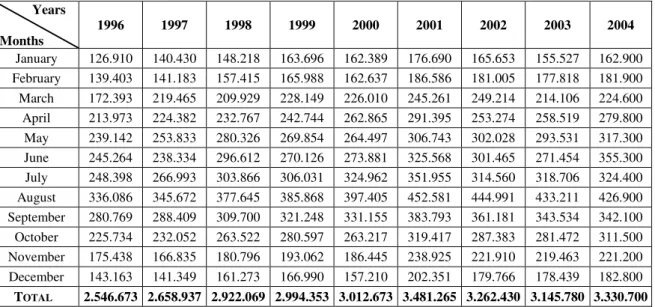EUROPEAN UNION’S HISTORY, CULTURE AND
CITIZENSHIP
UNIVERSITY OF PITE TI
FACULTY OF LAW AND ADMINISTRATIVE SCIENCES
Prediction Tourism Demand Using Artificial Neural
Networks
Fernandes, Paula (pof@ipb.pt) Department of Economics and Management
Teixeira, João (joaopt@ipb.pt) Department of Electrical Engineering School of Technology and Management (ESTiG) Polytechnic Institute of Bragança (IPB) Apartado 134, 5301-857 Bragança, Portugal Tel: +351273303103, Fax: +351273313051
ABSTRACT
The aim of this research is to quantify the tourism demand using an Artificial Neural
Network (ANN) model. The methodology was focused in the treatment, analysis and
modulation of the tourism time series: “Monthly Guest Nights in Hotels” in Northern
Portugal recorded between January 1987 and December 2006, since it is one of the
variables that better explain the effective tourism demand. The model used 4 neurons in the
hidden layer with the logistic activation function and was trained using the Resilient
Backpropagation algorithm. Each time series forecast depended on 12 preceding values.
The developed model yielded acceptable goodness of fit and statistical properties and
therefore it is adequate for the modulation and prediction of the reference time series.
1. INTRODUCTION
Tourism demand is usually measured in terms of the number of tourist visits from an origin country to a destination country. Alternative measures used to quantify tourism demand are tourist expenditures by visitors from an origin country in the destination country and the number of nights spent in the destination country (Witt & Witt, 1995). According with same authors accurate forecasts of tourism demand are prerequisite to the decision-making process in many organizations of the private or public sector. Any information concerning the future evolution of tourism flows is of great importance to hoteliers, tour operators and other industries concerned with tourism or transportation, in order to adjust their policy and corporate finance.
In this context, this paper examines the accuracy of a forecasting model in predicting tourism demand, as represented by the number of Monthly Guest Nights in Hotels in the North of Portugal. The Artificial Neural Networks (ANN) methodology is employed to forecast the volume of tourist from January 1987 to December 2006. This methodology was inspired in the biologic theories of human brain function. The human brain is composed of several non-linear processors densely interconnected operating in parallel, these being the principal advantages compared with other forecast techniques. This was achieved through a study of the reference time series whose past values were known and whose objective was to obtain a model that better predicts the behaviour of the time series under study.
This paper is organized in the following structure: first, there is an overview section that examines the summary theoretical foundation of neural networks. Based on the theoretical analysis, a neural network is developed for forecasting the “Monthly Guest Nights in Hotels” in Northern Portugal. Real data from official publications in Portugal is used for the neural network development. The analysis results of forecasting are described in the next section. Some concluding remarks are given in the final section.
2. NONLINEAR MODELLING APPROACH
model to interpret the data without known answers (Basheer & Hajmeer, 2000; Fernandes, 2005).
Neural networks are the most versatile nonlinear models that can represent both nonseasonal and seasonal time series. The most important capability of neural networks compared to other nonlinear models is their flexibility in modelling any type of nonlinear pattern without the prior assumption of the underlying data generating process (Haykin, 1999; Zhang, 2003).
A feedforward neural network learns from a supervised training data to discover patterns connecting input and output variables. Feedforward recall is a one-directional information processing neural network in which the signal flows from the input units to the output units in a forward direction (Kuan & White, 1994; Nam & Schaefer, 1995; Yao et al., 2000).
Backpropagation is the most popular neural network training algorithm that has been used to perform learning on feedforward neural networks. It is a method for assigning responsibility for mismatches to each of the processing units in the network, which is achieved by propagating the gradient of the activation function back through the network to each hidden layer, down to the first hidden layer. The weights are then modified so as to minimize the mean squared error between the network’s prediction and the actual target (Thawornwong & Enke; 2004). The Backpropagation neural network consists of an input layer, an output layer and one or more intervening layers also referred to as hidden layers. The hidden layers can capture the nonlinear relationship between variables. Each layer consists of multiple neurons that are connected to neurons in adjacent layers. Since these networks contain many interacting nonlinear neurons in multiple layers, the networks can capture relatively complex phenomena (Hill et al., 1996; Chiang et al., 1996; Basheer & Hajmeer; 2000). Many variant were developed of Backpropagation training algorithm. In our case we adopted the Resilient Backpropagation [RP] (Reidmiller & Braun, 1993), because it can combine fast convergence, stability and generally good results.
The most popular feedforward three-layer network for forecasting problems can be written as (Fernandes, 2005):
2,1 1,
1 1
n m
t j ij t i j
j i
Y
b
w f
W y
−b
= =
=
+
+
[1]where,
m
, is the number of input nodes;n
, is the number of hidden nodes; f , is ahidden to output nodes;
{
W iij, =0,1, , ;m j=1, 2, ,n}
, are weights fromthe input to hidden nodes; b2,1and b1,j, are the bias associated with the nodes
in output and hidden layers, respectively.
The equation shows a linear transfer function used in the output node. The input variables are the lagged past observations if the time series data are used in model building.
3. PREDICTION TOURISM DEMAND IN THE NORTH OF
PORTUGAL
3.1. DESIGNING AN NEURAL NETWORK MODEL
The data used in this research are MonthlyGuest Nights in Hotels in the North of Portugal, published in the Portuguese National Statistical Institute. The total sampling period examined is from January 1987 to December 2006 (see Table A.1, in Appendix).
0 70 140 Km
Centre
Alentejo
Algarve
Lisbon
Madeira
North
Azores
Spain
Legend
Border of NUT II
0 40 Km
0 150 Km
0 100,000 200,000 300,000 400,000 500,000 600,000 J a n -8 7 J a n -8 8 J a n -8 9 J a n -9 0 J a n -9 1 J a n -9 2 J a n -9 3 J a n -9 4 J a n -9 5 J a n -9 6 J a n -9 7 J a n -9 8 J a n -9 9 J a n -0 0 J a n -0 1 J a n -0 2 J a n -0 3 J a n -0 4 J a n -0 5 J a n -0 6 M onths N .º o f O v e rn ig h t [a] 9.50 10.00 10.50 11.00 11.50 12.00 12.50 13.00 13.50 J a n -8 7 J a n -8 8 J a n -8 9 J a n -9 0 J a n -9 1 J a n -9 2 J a n -9 3 J a n -9 4 J a n -9 5 J a n -9 6 J a n -9 7 J a n -9 8 J a n -9 9 J a n -0 0 J a n -0 1 J a n -0 2 J a n -0 3 J a n -0 4 J a n -0 5 J a n -0 6 M onths L O G ( N .º o f O v e rn ig h t) [b]
The Northern region of Portugal is delimited in Fig 1. The time series “Monthly Guest Nights in Hotels” presents a clear increasing seasonality (Fig. 2a), the natural log-transformation is performed to stabilize the seasonal variations and variance, and we have another time series. During this study we call this time series, the Transformed Original Data [TOD] (Fig. 2b).
Fig. 2: Overnights in the North of Portugal from 1987:01 to 2006:12: [a] Original Data; [b] Transformed Original Data.
The ANN model used in this study is the standard three-layer feedforward network. Since the one-step-ahead forecasting is considered, only one output node is employed. The activation function for hidden nodes is the logistic function
[Logsig]: ( )
1 ( )
1 e x
f x = −
+ ; and for the output node the identity function [Lin]: f x( )=x.
Bias terms are used in both hidden and output layer’s nodes. The fast Resilient
Backpropagation algorithm1 is employed in training process. The ANN is randomly initialised with weights and bias values. The selection of the architecture is supported in the author’s work Fernandes (2005), Fernandes and Teixeira (2007). For selecting the architecture several experiments with different architectures was carried out (train and test) and selected the better architectures according to the results in a validation set using hundreds of training session. The elected architecture consists of 12 input nodes in the entrance layer, 4 hidden nodes in the second layer and one node in the output layer (1-12;4;1). The input of the model consists of the 12 previous numbers, corresponding to the last 12 months overnights. The output is the predicted overnights for the next month.
Several training sessions for each identified situation have been performed with different initial weights. From this number of training sessions we retain the ANN
(concerning its weights) that obtain better forecast results in each situation under the validation set. In this particular situation we performed 250 training sessions.
In order to compare the performance, the root mean squared error (RMSE2) between the observed and predicted values are used as the agreement index and we adopted this index to select the best ANN model.
Also in the training process, for each session we need to establish the number of iterations and the goal. In the present study we defined our goal as an error (RMSE between target and predicted values) of the order of 1x10-4.
The data sample was divided in a sub-set for training, a sub-set for validation and a sub-set for test. The data set between January 1988 until December 2003 was used for training. It must be notice that the data between January and December 1987 was used as the input data for predicting January 1988 till December. The data between January and December 2004 was used for the validation set. This set is used for early stop training if the RMSE does not decrease in a number (5 in this case) of training iterations. This early stop training condition avoids the ANN to over fit the training data without improvements in a data not used in the training phase. Finally the data between January 2005 and December 2006 was used as data never seen in the training and selection process and used just to present the results of the model with never seen data.
4. RESULTS AND DISCUSSION
In this section we will examine the results of ANN under the test set. For this purpose we will compare the predicted data of ANN with the target values (original data) for the years 2005 and 2006 (the test set). The selection process of the better ANN is controlled by the minimum RMSE in the training set.
We should look at the performance in the test set. The predicted values for the years of 2005 and 2006 with ANN model and its APE and MAPE are presented in Table 1. APE is the absolute percentage error given by the expression [2]. MAPE is the Mean absolute percentage error given by the expression [3].
ˆ 100.
t t
t
Y Y
Y
=
− ×
APE [2]
2
( )2
1 ;
n t t t
A P
RMSE
n =
1
ˆ 1
100. N
t t
t t
Y Y
N = Y
−
= ×
MAPE
[3]
Table 1: Prediction Tourism Demand with ANN model, APE and MAPE in the period 2005:01 to 2006:12.
2005 2006
TOD TOD
Values APE
Target Data
Months Target
Data Values APE
182.389 8.5% 168100 January 180.700 189.349 4.8% 181.870 9.0% 166800 February 195.100 183.731 5.8% 220.635 10.7% 247000 March 237.200 234.591 1.1% 284.692 6.0% 268500 April 352.600 285.916 18.9% 301.171 5.0% 316900 May 361.200 316.248 12.4% 333.732 8.5% 307700 June 331.500 312.298 5.8% 340.731 5.0% 358500 July 388.400 376.036 3.2% 416.740 11.8% 472400 August 524.500 414.580 21.0% 357.019 1.4% 362200 September 406.500 363.306 10.6% 328.557 4.0% 315900 October 353.300 337.129 4.6% 237.594 1.8% 233400 November 258.800 264.057 2.0% 196.989 11.0% 221300 December 254.700 218.612 14.2%
---- 6.9% ---- MAPE ---- ---- 8.7%
Analysing the presented results in Table 1 and according to the Criteria of MAPE for Model Evaluation in Lewis (1982), the predicted data with the selected model has a highly accurate forecast, because the results are lower than 10%. We can say the predicted data for each year follow the behaviour of the target data. Therefore, in Table 1 we can observe an additional difficulty for the model imposed by the fact those years 2005 and 2006 have and increasing number of overnights, and this increasing phenomenon was present in the training set only in 2001. This phenomenon was due to the fact that the city of Guimarães and the Douro Region were considered World Cultural Heritage, and the city of Porto was the European Capital of Culture in 2001 (Fernandes & Teixeira, 2007).
5. CONCLUSIONS
sub-set for training, in a validation set, to stop the training process earlier and a test data set to examine the level of forecasting accuracy.
The model has 4 neurons in the hidden layer with the logistic activation function and was trained using the Resilient Backpropagation algorithm. The ANN model has the 12 preceding values as the input. The analysis of the output forecast data of the selected ANN model showed a relatively close result compared to the target data.
Finally and considering the results, the developed model yielded acceptable goodness of fit and statistical properties and therefore it is adequate for the modulation and prediction of the reference time series; and the ANN methodology becomes interesting to forecast because it allows the use of a non linear model for seasonal time series
REFERENCES
Basheer, I.A. and Hajmeer, M.; “Artificial Neural Networks: fundamentals, computing, design and application”; Journal of Microbiological Methods; N.º 43, (2000); pp.3/31.
Chiang, W.C.; Urban, T.L. and Baldridge, G.W.; “A neural network approach to mutual fund net asset value forecasting”; Omega, The International Journal of Management Science; Vol. 24, N.º 2, (1996); pp. 205/215.
Fernandes, Paula Odete; “Modelling, Prediction and Behaviour Analysis of Tourism Demand in the North of Portugal”; Ph.D. Thesis in Applied Economy and Regional Analysis; Valladolid University - Spain; (2005).
Fernandes, Paula O. and Teixeira, João Paulo; “A new approach to modelling and forecasting monthly overnights in the Northern Region of Portugal”; Proceedings of the 4th International Finance Conference; Université de Cergy; Hammamet, Medina, Tunísia; (2007).
Haykin, Simon; “Neural Networks. A comprehensive foundation”; New Jersey, Prentice Hall; (1999).
Hill, Tim; O’Connor, Marcus and Remus, William; “Neural network models for time series forecasts”; Management Science; Vol. 42, N.º 7; (1996); pp.1082/1092.
Kuan, Chung-Ming and White, Halbert; “Artificial Neural Network: An econometric perspective”; Econometric Reviews;N.º 13; (1994); pp.1/91.
Nam, Kyungdoo and Schaefer, Thomas; “Forecasting International Airline Passenger Traffic Using Neural Networks”; Logistics and Transportation Review; Vol. 31, N.º 3; (1995); pp.239/251.
Reidmiller, M and Braun, H.; “A direct adaptive method for faster backpropagation learning: The RPRO algorithm”; Proceedings of the IEEE International Conference on Neural Networks; (1993).
Thawornwong, Suraphan and Enke, David; “The adaptive selection of financial and economic variables for use with artificial neural networks”; Neurocomputing; N.º 56; (2004); pp.205/232.
Witt, S. F. and Witt, C. A; “Forecasting Tourism Demand: a review of empirical research”; International Journal of Forecasting; N.º 11; (1995); pp. 447/475.
Yao, Jingtao; Li, Yili and Tan, Chem Lim; “Option price forecasting using neural networks”; Omega, The International Journal of Management Science; N.º 28; (2000); pp.455/466.
APPENDIX A
Table A.1:Overnights in the North of Portugal from 1987:01 to 1995:12 (cont.).
Years
Months
1987 1988 1989 1990 1991 1992 1993 1994 1995
January 102.447 118.011 122.217 126.671 126.826 124.194 121.469 118.606 122.480
February 102.123 117.547 116.837 129.802 131.653 127.474 129.284 122.988 130.393
March 125.401 142.687 160.658 158.701 188.999 157.536 154.734 175.261 156.645
April 150.042 167.118 169.326 197.757 182.290 196.087 189.142 185.525 209.263
May 180.430 189.823 199.158 207.876 219.187 223.918 198.402 232.075 218.666
June 197.113 207.729 218.595 227.159 251.295 207.907 207.216 248.237 222.720
July 229.293 254.523 252.634 257.633 273.927 231.801 231.453 246.274 247.589
August 304.847 315.113 329.014 351.500 341.490 312.026 304.576 322.366 320.750
September 238.542 258.287 278.074 284.867 283.378 259.023 249.583 266.094 269.433
October 173.503 174.359 189.664 216.286 197.241 205.400 202.792 206.256 196.466
November 130.187 137.933 138.683 162.062 152.554 149.289 141.976 144.803 152.340
December 114.229 128.774 127.730 139.683 132.802 130.963 120.748 139.706 140.643
TOTAL 2.048.157 2.211.904 2.302.590 2.459.997 2.481.642 2.325.618 2.251.375 2.408.191 2.387.388
Table A.1:Overnights in the North of Portugal from 1996:01 to 2004:12.
Years
Months
1996 1997 1998 1999 2000 2001 2002 2003 2004
January 126.910 140.430 148.218 163.696 162.389 176.690 165.653 155.527 162.900
February 139.403 141.183 157.415 165.988 162.637 186.586 181.005 177.818 181.900
March 172.393 219.465 209.929 228.149 226.010 245.261 249.214 214.106 224.600
April 213.973 224.382 232.767 242.744 262.865 291.395 253.274 258.519 279.800
May 239.142 253.833 280.326 269.854 264.497 306.743 302.028 293.531 317.300
June 245.264 238.334 296.612 270.126 273.881 325.568 301.465 271.454 355.300
July 248.398 266.993 303.866 306.031 324.962 351.955 314.560 318.706 324.400
August 336.086 345.672 377.645 385.868 397.405 452.581 444.991 433.211 426.900
September 280.769 288.409 309.700 321.248 331.155 383.793 361.181 343.534 342.100
October 225.734 232.052 263.522 280.597 263.217 319.417 287.383 281.472 311.500
November 175.438 166.835 180.796 193.062 186.445 238.925 221.910 219.463 221.200
December 143.163 141.349 161.273 166.990 157.210 202.351 179.766 178.439 182.800

![Fig. 2: Overnights in the North of Portugal from 1987:01 to 2006:12: [a] Original Data; [b]](https://thumb-eu.123doks.com/thumbv2/123dok_br/16981794.762957/5.892.63.823.345.570/fig-overnights-north-portugal-original-data-b.webp)

